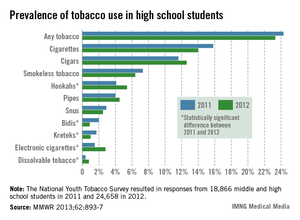Overall use of tobacco among high school students decreased from 2011 to 2012, but cigar and pipe smoking went up, as did the use of some nonconventional products, the Centers for Disease Control and Prevention reported.
In 2012, 23.3% of high school students surveyed reported current tobacco use, compared with 24.3% in 2011. Use of cigars, driven largely by a significant increase among non-Hispanic black students, went from 11.6% in 2011 to 12.6% in 2012, and pipe use rose from 4.0% to 4.5%, according to data from the National Youth Tobacco Survey.
"Youths are known to have higher rates of cigar use than adults, which might be related to the lower price of some cigars (e.g., cigarillos and ‘little cigars’) relative to cigarettes, or the marketing of flavored cigars that might appeal to youths," the report said (MMWR 2013;62;893-7).
Significant increases in use were seen for electronic cigarettes (1.5% in 2011 to 2.8% in 2012) and hookahs (4.1% to 5.4%), but the use of other nonconventional products such as bidis (small brown cigarettes wrapped in a leaf), kreteks (clove cigarettes), and snus declined, the CDC noted.
The 2012 National Youth Tobacco Survey was conducted at 228 schools, with 24,658 middle and high school students responding. The 2011 survey had a sample size of 18,866.


